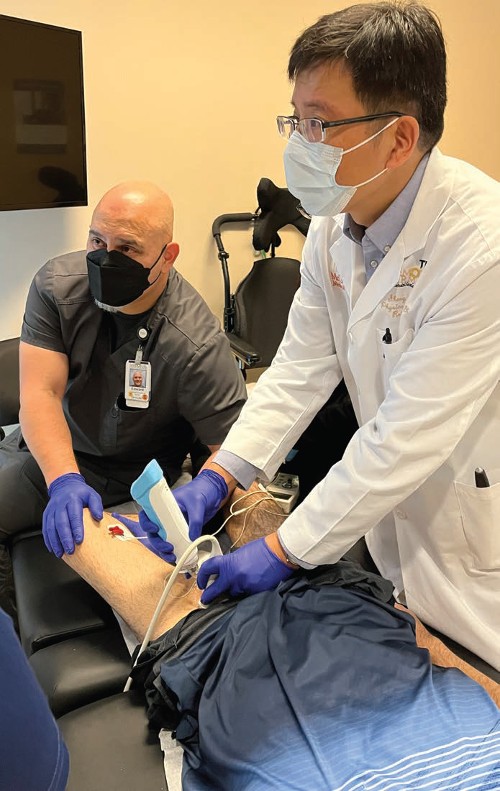
Spasticity is an often-painful complication associated with central nervous system disorders that can cause muscles in any part of the body to involuntarily contract and become stiff, which can lead to jerky or exaggerated movements. It is frequently a complication of cerebral palsy, multiple sclerosis, stroke, brain and spinal cord injuries, and amyotrophic lateral sclerosis (also known as Lou Gehrig’s disease). According to Dr. Li, serious cases of spasticity can dramatically affect a person’s quality of life and ability to do common everyday tasks, such as dressing, eating, walking, showering and getting into or out of bed.
Dr. Li was the first physician in the United States to use cryoneurolysis to provide patients with relief from spasticity. The noninvasive procedure involves inserting a needlelike probe containing highly pressurized nitrous oxide gas chilled to –90 degrees Celsius into the skin and placing it on the nerve that is causing the condition. The extreme cold forms a tiny ice ball on the tip of the probe that freezes and temporarily damages the targeted nerve without affecting the surrounding tissue. This stops the nerve from sending signals to the brain that trigger the muscle spasms and pain. The procedure takes about 30 minutes to complete.
“Cryoneurolysis is the first advancement in treating spasticity in years,” Dr. Li says. “It enables tight muscles to relax, which increases range of motion and eases pain.”
The procedure offers many advantages over conventional treatments, including:
- Oral medications
- Botulinum toxin injections
- Phenol neurolysis
- Surgery
“Unlike these treatments, cryoneurolysis doesn’t involve taking drugs or injecting neurotoxins into the body, both of which can have negative side effects,” Dr. Li notes. “And it isn’t as invasive as surgery.”
Although results vary, the vast majority of cryoneurolysis patients experience significant immediate relief, while some of the other options take days or even weeks to take full effect.
“The benefits of cryoneurolysis usually last five to 10 months, depending on the individual and severity of their spasticity. That’s several months longer than the alternatives,” Dr. Li notes.
As the damaged nerve slowly regenerates, the condition typically returns, but research indicates the symptoms are often not as severe. Another benefit is that Dr. Li and his team have successfully repeated the procedure for a number of patients, with successful outcomes—in some cases multiple times.
Edward Castaneda, a licensed vocational nurse who assists Dr. Li, praises the latter’s advanced expertise in cryoneurolysis. “It’s amazing to watch the skill with which Dr. Li performs the procedure and see the profound difference it makes for patients, many of whom come to us with acute symptoms and experience near total relief,” Castaneda emphasizes. “I’ve had patients tell me cryoneurolysis has literally given them back their life.”
“It’s gratifying to help those dealing with spasticity achieve excellent results and be able to resume some, if not all, of their activities of daily living,” Dr. Li adds.
